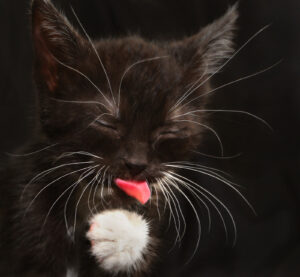Barks Blog
Feline Behavior Unmasked: Emesis in Cats – Common but Not Normal
By Dr. Liz Bales

Q: I have 2 cats. One throws up constantly. She has thicker fur (she a tortie) than the other. I try to brush her as often as I can but she’s not a huge fan. Any advice would be greatly appreciated!
A: This is such an important and misunderstood topic. We can help a lot of cats and the people who love them with this information.
Most cat parents deal with cat vomit. Vomit is so common in the regular life with cats that we have come to accept it as normal. Let me be very clear, vomiting in cats is common, but it is not normal. If your cat is vomiting more than once a month, there is a problem and you should take your cat to the vet.
So, what could it be? The answer is lots of things, ranging from gobbling up food too fast, to food allergies, to systemic diseases like kidney or thyroid disease, to inflammatory bowel disease and even cancer. All of these things may look very similar. The only way for your veterinarian to get to the bottom of the problem is with a thorough history and physical exam. Based on those results, your vet may recommend blood work, radiographs, ultrasound and even biopsies to get a diagnosis.
This sounds extreme when you are pretty sure it’s just a hairball, right? Well, hairballs are also common, but not normal. Cats are designed to groom and, in the process, consume hair. You cannot brush your way into a solution here. This hair should pass normally through the gastrointestinal (GI) tract and not need to be vomited up. If your cat is vomiting hairballs, either he is overgrooming (due to stress or fleas or other causes of itchiness) and consuming more hair than his body can handle, or there is a motility problem in the GI tract that is preventing the hair from passing normally through it. There is a long list of causes for altered GI motility. Again, the best way to get to the bottom of this and help your cat is with a veterinary visit.
Please let us know how things go for you and your cat. If your cat gets a clean bill of health at the veterinarian, we can talk about the ways to reduce stress for your cat by introducing more enrichment into his environment. In fact, this is my very favorite topic! But first we need to make sure there is not an underlying medical condition that needs attention. We will be waiting to hear back from you!
For further assistance with feline behavior issues, see
PPG Feline Resources: https://petprofessionalguild.com/Feline-Resources,
or find your closest feline behavior professional: https://petprofessionalguild.com/Find-Your-Feline-Professional
About the Author
Dr. Liz Bales VMD is a graduate of the University of Pennsylvania School of Veterinary Medicine who has a special interest in the unique behavioral and wellness needs of cats, including feline behavior and environmental enrichment. She is a writer, speaker and featured expert in all things cat around the globe including appearances on Fox and Friends, ABC News, The Dr. Katy Pet Show and Cheddar. She is also the founder of Doc and Phoebe’s Cat Company, and the inventor of The Indoor Hunting Feeder for cats. Dr. Bales has been a guest speaker at the University of Pennsylvania School of Veterinary Medicine and the University of California Davis School of Veterinary Medicine. She also sits on the Dean’s Alumni Council at the University of Pennsylvania, the Advisory Board for the American Association of Feline Practitioners Cat Friendly Practice, and the Advisory Board of Fear Free.
